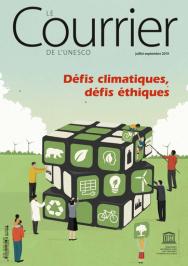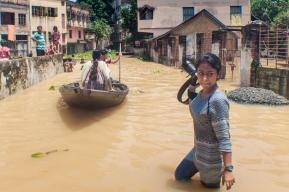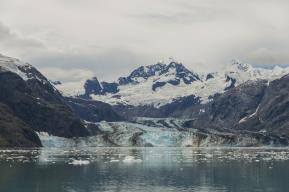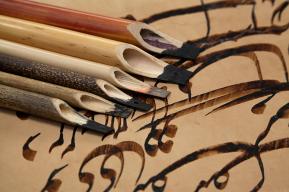مقال
كولونيل: الأمر عاجل!

خمول ونعاس. تلك هي حالة الرأي العام ووسائل الإعلام أمام تغيّر المناخ، حسب الفنان الفرنسي-الدانماركي تياري جوفروا المكنى كولونيل. وبعد أن تردّد بين شعار «قبل فوات الأوان»، و«غدا، سيكون قد قُضي الأمر»، مرّ للإعلان عن «فوات الأوان» (تو لايت). ومع ذلك، يستمدّ من اليأس شيئا من المواساة.
تياري جوفروا المكنى كولونيل يُجيب عن أسئلة نيلس بويل
يُمثّل أحد أعمالك الحديثة حروفا بالنيون الأحمر تُشكّل جملة «قررت أن أستسلم» (آي غيف آب). هل فقدت الأمل في الفوز في السباق ضد تغيّر المناخ؟
نعم. ولا أدري إن كان ذلك بسبب تقدّمي في السن أم لأن الوضع يزداد تأزّما. لم نعد نعيش في حالة خوف، وإنما في يقين بأنه «فات الأوان». لكني لا أعتقد أن ذلك يدعو إلى الاستسلام. وقد يكون اليأس تحديدا هو الذي سيُوقظ، أخيرا، الضمائر الناعسة. فالعالم أجمع، تقريبا، يعلم بوجود تغيّر المناخ ومسؤولية النشاط الإنساني في تأزمه، ورغم ذلك لا أحد، تقريبا، يُحرك ساكنا.
تكمن المشكلة في اللامبالاة وليس في الجهل. يُخيّل إليّ أننا نعيش في عالم تجوب الطائرات سماءه ليلا نهارا وتبعث موادّ مُخدّرة تشلّ وعينا. ويقع على عاتق وسائل الإعلام قسط كبير من المسؤولية: فهي تسكت عن الأسباب الحقيقية للظواهر المناخية القصوى التي نشهدها، حتى لا تُشكّك في نظام الإنتاج والاستهلاك الذي ترتكز عليه سلطة النّخب. علما بأن وسائل الإعلام هذه ليست سوى جزءا من تلك النخب ذاتها.
أعتقد أن للفنانين دورا في إيقاظ الضمائر. فهم قادرون على كشف دواليب الدعاية الإعلامية، وبإمكانهم أن يُظهروا للعموم الوجه الحقيقي للمشاكل.
ذلك هو الهدف من مشروعك إيمرجنسي روم (غرفة الطوارئ)، أليس كذلك؟
فعلا، فالمهمّ في عملي حول تغيّر المناخ يتمثّل في طرح السؤال التالي: «في ما تتمثل حالة الطوارئ؟». وكما هو الشأن بالنسبة إلى غرف الطوارئ في المستشفيات، فإنه لا يُمكن معالجة كافة الحالات الطارئة في نفس الوقت، وإنما يجب تحديد تلك التي تستوجب المعالجة في أسرع وقت. ومن البديهي أن تغيّر المناخ يُمثّل أولويّة الأولويات. فهو – وسيظلّ – سبب العديد من الطوارئ: الانتقال المُكثّف للسكان، المشاكل البيئيّة، الحروب...
صمّمت إذن مشروعا، أو بالأحرى إطارا، يتيح للفنانين المعاصرين التعبير العاجل عن رأيهم في الأحداث التي تنقلها وسائل الإعلام. إنهم يترصّدون ويُعاينون ما يحدث حولهم ويردّون الفعل في الحين تقريبا، وذلك بابتكار عمل يعرضونه في غرفة الطوارئ في اليوم الموالي، ليُناقشوه مع الجمهور.
وحتى أعطيك مثالا على ما حدث في أول غرفة طوارئ جُهّزت في موما بس1، بنيويورك، أذكر عمل الفنان الدانماركي سوران دهلغارد، الذي أنتج، غداة عواصف ثلجية شديدة جدا، نسخا من أكبر صحف العالم، حتى يجلب انتباه الجمهور حول تغيّر المناخ. كانت العناوين تُعلن عن كوارث في كل مكان.
يجب التذكير بأن هذا الحدث يعود لسنة 2007 وأن الجمهور اهتزّ له فعلا. أما اليوم فلا أحد يُحرّك شعرة أمام مثل تلك العناوين! لكن، كما كنت أقول، لا يجب أن يجرنا ذلك للاستسلام. ولن أكفّ عن إنشاء غرف طوارئ هنا وهناك عبر العالم. فأنا أعتمد على أن تؤول النقاشات التي تدور هناك إلى كسب جماهير جديدة وتحسيسها.
تستعمل مواد قابلة لإعادة الاستخدام في أعمالك. هل هو اختيار مُتعمّد؟
هو اختيار فرضته ظروف العمل الفوري. ألتقط علبة من الكرتون في الشارع لأكتب عليها. وأقضي أكثر الوقت في محاولة فهم الأحداث والتواصل مع الجمهور، بدلا من تحسين عملي بمفردي في ورشتي أو في الاستوديو. ليس لدي وقت للإتقان. لا بد من التحرك بعجالة.
ابتكرت مفهوما آخر وهو كريتيكل ران. فيمَ يتمثّل؟ ما هو هدفه؟
السباقات الناقدة هي في الحقيقة محاضرات حول قضايا الساعة وخاصّة منها تغيّر المناخ. ولكن، عوض أن يكون المُشاركون جالسين في مكان مكيف، في قاعة محاضرات مُريحة، يترصّدهم النعاس بسبب الحرارة وخرير المصابيح الضوئية، فهم مدعوّون للركض خلال الحوار!
كريتيكل ران هي تعبير مجازي: نحن نركض حتى ننقذ ما يمكن إنقاذه إذا لم يفت الأوان، أو نركض بحثا عن النجاة لأنه فات الأوان. وإن فات الأوان فعلا، فسوف لن نبقى جالسين على الكراسي نتصفّح كتب تاريخ الفنون...
نظمت في شهر مايو الأخير كريتيكل ران في بينالي البندقية، في إيطاليا، لإثارة التساؤل، بالخصوص، حول عنوان دورة 2019 لذلك المعرض الدولي الكبير للفن المعاصر: «ماي يو ليف إن أنتيريستنغ تايمز» (نتمنى لكم أن تعيشوا أوقاتا شيّقة).
فعلا. وقد تمّ طرح أسئلة سديدة خلال ذلك السباق-الحوار. وتناول أحد المشاركين موضوع أهمّ عمل عرض خلال بينالي هذه السنة، وهو باركا نوسترا (مركبنا) للفنان الأيسلندي-السويسري كريستوف بوشال. ويتمثل هذا العمل في حطام مركب غرق في البحر الأبيض المتوسط سنة 2015، مخلفا جثث حوالي ألف مهاجر. ورأى هذا المشارك أنه كان من الأفضل عرض إحدى السفن التي تقوم بالرحلات البحرية، والتي تفرض، بمفعول تسلسلي، على شعوب بأكملها الهجرة لأسباب مناخيّة.
أرى أنه من الأفضل أن تُعرض في البينالي أعمال تتناول مصدر المشاكل وتحثّنا على محاولة حلّها في الوقت المناسب، بدل أعمال تُجسّد بتهكّم فكرة «فات الأوان» وإنكارنا للواقع.
الصورة: إيمرجنسي روم
Interview by Niels Boel, Danish journalist.
One of your most recent works consists of red neon letters that say “I give up”. Have you lost hope that we will win the race against climate change?
The answer is yes. I don't know if it's because I'm getting older or because the situation is getting worse. We no longer live in fear, we live in “it's too late”. But I don't think that means we’re giving up. For it is perhaps precisely this despair that will finally rouse sleeping consciences! Almost everybody is aware of climate change and the responsibility of human activity. And yet nobody, almost nobody, does anything.
The problem isn’t ignorance, it’s apathy. I have the impression we live in a world where planes fly across the sky day and night, spraying sleep-inducing substances that atrophy our consciousness. The media has a lot to do with this – they ignore the real causes of the extreme weather phenomena we are witnessing, so that we don’t question the system of production and consumption on which the power of the elites is based. Knowing that the same media is part of these same elites.
I think that artists have a role to play in raising awareness. They can detect the workings of media propaganda. They can show the public the real face of the problems.
That's the purpose of your Emergency Room project, isn't it?
Indeed, the essence of my work on climate change is to ask the question: “What’s the emergency?” Just as in hospital emergency wards, it isn’t possible to treat all emergencies at the same time – it’s necessary to identify those that need to be treated as soon as possible. It’s clear that climate change is the priority of all priorities. It is – and will be – the cause of many other emergencies: massive population movements, ecological problems, wars, etc.
So I imagined a project – or rather, a format – that allows contemporary artists to urgently express themselves on the news transmitted by the media. They’re on the lookout, observing what’s happening around them and reacting almost in real time – creating a work that they display in the Emergency Room the next day, to discuss it with the public.
To give you an example, for the first Emergency Room installed at MOMA PS1 in New York, the Danish artist Søren Dahlgaard had produced – in the aftermath of very heavy snowstorms – fake copies of the world's most influential newspapers to draw public attention to climate change. The headlines announced disasters everywhere.
That was in 2007, and the public was really shaken by it. Today, no one would bat an eye seeing such topical headlines! But, as I was saying, that does not mean we should give up. I continue to set up Emergency Rooms all over the world. I’m counting on the fact that the debates taking place there will eventually win over and raise awareness among new audiences.
You use recyclable materials for your works. Is this a deliberate choice?
It’s the fact of working in the present that imposes this choice. I’ll go find a box in the street and write on it. I will spend more time trying to understand what’s going on and communicating with the audience than on polishing my work alone in my workshop or studio. There’s no time for perfecting. We must act quickly.
Critical Run is another art format you have created. What does it entail, and what’s the objective?
Critical Runs are in fact conferences on current topics, particularly climate change. But instead of participants sitting in a warm, comfortable conference room, drowsy from the heat and the whirring of projectors, they’re invited to debate while running!
Critical Run is a metaphor: either we run to save the world, as long as it’s not too late, or we run to save ourselves, because it’s too late. If it's really too late, we're not going to sit on chairs and leaf through the history of art.
In May 2019, you organized a Critical Run at the Venice Biennale to reflect upon the title of the 58th edition of this major international art exhibition: May You Live in Interesting Times.
Yes. And some good questions were asked during this race-debate. One of the participants discussed the main work of this year's Biennale, Barca Nostra (Our boat) by Christoph Büchel. This Icelandic-Swiss artist is exhibiting the wreck of a fishing vessel that sank in the Mediterranean in 2015, killing about a thousand migrants. Our participant suggested it would have been better to exhibit one of those cruise ships – which, through a chain reaction, causes entire populations to be condemned to migrate for climatic reasons – instead.
The Biennale should exhibit works that evoke the causes of problems and encourage us to try to solve them in time, not works that ironically embody our attitudes that it is “too late” and of us turning our backs.
Photo: Emergency Room
Thierry Geoffroy
The son of a soldier, French-Danish artist Thierry Geoffroy has adopted the nom de guerre, Colonel, to indicate that he is fighting a battle: to raise public awareness of climate change. Originally a photographer, Geoffroy has been touring art fairs, galleries and museums in many countries for over a decade. He invites himself, even when not invited, to communicate his messages. Author of several books and manifestos, he has produced more than twenty films for Danish television and as many solo shows in museums.










